Moist heat vanishes during sun-based meals mainly due to improper sealing and container selection. You'll lose heat through reflection, absorption, transmission, and leakage – with moisture loss being a significant concern. To prevent this, you'll need tight-fitting lids that create sealed environments and trap steam. Dark metal containers with proper lids work best, while transparent covers like glass bowls or cooking bags help maintain temperatures up to 300°F. Weather conditions also play a role, as hot, humid days increase moisture retention while arid conditions can dry out your food. Understanding these factors will transform your solar cooking experience.
Understanding Solar Heat Escaping Mechanisms
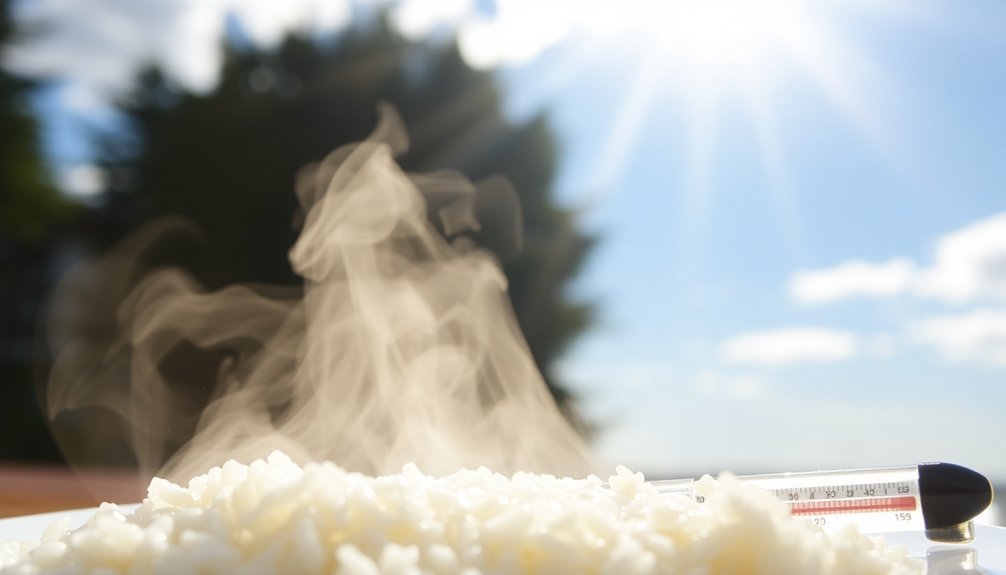
While solar cookers harness the sun's energy effectively, understanding how heat escapes is essential for maximizing their performance.
You'll encounter four main types of heat loss when using your solar cooker: reflective, absorption, transmission, and leakage losses.
When solar radiation bounces off surfaces instead of being absorbed, you're experiencing reflective loss.
Absorption losses occur during the conversion of solar energy to heat, while transmission losses happen when radiation passes through the cooker's transparent surfaces.
The most significant concern is often leakage loss, which happens due to temperature differences between the inside and outside of your cooker.
If your cooker isn't properly insulated, you'll lose heat through convection as warm air escapes and cooler air enters through gaps. Modern solar thermal systems can integrate with your food processing applications to minimize these heat losses.
Moisture Loss Prevention Methods
You'll find that tight-fitting lids are essential for trapping moisture when preparing sun-based meals, as they create a sealed environment that prevents water vapor from escaping.
Transparent lids offer the added advantage of allowing sunlight to penetrate while maintaining the trapped moisture, effectively creating a miniature greenhouse effect for your food.
Adding hydrating ingredients like cucumber slices and watermelon chunks to your sun-based dishes helps maintain optimal moisture levels during cooking.
Tight-Fitting Lid Techniques
Three essential techniques guarantee proper moisture retention when cooking with tight-fitting lids.
First, you'll need to verify your lid creates a complete seal around the pot's rim, preventing steam from escaping. If you don't have a proper lid, you can use aluminum foil as a temporary solution by molding it tightly over the pot's edges and folding it securely. This cost-effective method using readily available foil can save you from purchasing new lids.
Second, you'll want to monitor the integrity of your seal throughout cooking. Check for gaps or tears if using foil, and adjust as needed.
Finally, you should avoid lifting the lid unnecessarily during cooking, as this releases accumulated heat and moisture. When you must check your food, do it quickly and reseal immediately.
Transparent Heat Trap Benefits
Because effective moisture retention is crucial for successful solar cooking, transparent heat traps serve as essential tools for maintaining both heat and humidity. You'll find these traps can help you achieve temperatures up to 300°F in panel cookers and even 550°F in evacuated tube systems, while keeping your food's natural moisture locked in.
| Feature | Benefit |
|---|---|
| Material Options | Use glass bowls, jars, or clear bags |
| Temperature Range | 250-550°F depending on cooker type |
| Moisture Control | Preserves food's natural juices |
You can create your own heat trap using readily available materials like clear cooking bags or stacked glass bowls. These versatile solutions not only trap important heat but also maintain humidity levels that preserve your food's nutrients and flavor. Plus, they're portable and perfect for outdoor cooking situations.
Optimal Container Selection
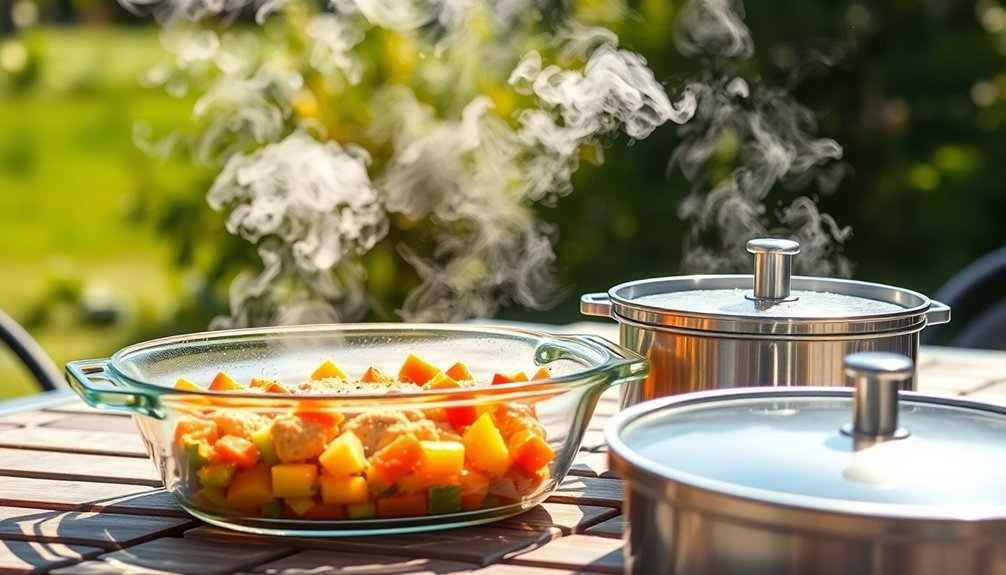
Your choice of lid type is essential for trapping steam and maintaining consistent cooking temperatures in sun-based meal preparation.
Dark metal containers with tight-fitting lids work best since they absorb and retain heat more effectively than lighter-colored materials.
When selecting your cooking vessel, opt for black or dark blue containers with secure, heavy lids that won't let precious moisture escape during the cooking process.
Lid Types Matter Most
When selecting containers for moist heat cooking, the lid's design proves most critical for maintaining optimal temperatures.
You'll want to focus on lids with pressure relief holes, as they retain 99% of heat while keeping you safe from pressure buildup.
Choose tight-fitting lids made from titanium or aluminum, depending on your needs.
Titanium won't absorb heat, making it ideal for consistent temperature control, while aluminum offers a lighter weight option with moderate thermal conductivity.
You'll find that handles don't affect heat retention, but they do add convenience.
Remember to match your lid material with your pot's composition for best performance.
By minimizing air space and ensuring a snug fit between pot and lid, you'll maintain higher cooking temperatures.
Consider adding insulation around your container to enhance heat retention further.
Dark Metals Trap Heat
The color of your cooking container plays a powerful role in heat absorption and retention. When you're preparing sun-based meals, dark metals will absorb more heat across visible and infrared light spectrums, leading to faster cooking times. However, you'll need to monitor your food carefully, as this increased absorption can cause overbrowning.
| Property | Dark Metals | Light Metals |
|---|---|---|
| Heat Absorption | High | Low |
| Cooking Speed | Fast | Slow |
| Browning Risk | High | Low |
| Cooling Rate | Quick | Gradual |
While dark metals cool faster through radiation, they'll still heat your food more efficiently than lighter alternatives. You'll find that dark metal containers work best for shorter cooking times, while shiny metals offer more control but require longer exposure. If you're using glass containers, remember they retain heat well but don't conduct it as effectively as metals.
Sealing Techniques for Solar Cooking
Proper sealing techniques form the foundation of successful solar cooking, ensuring that precious heat and moisture remain trapped within your cooking vessel.
You'll need to seal your cooking containers using either tight-fitting lids on dark metal pots or properly secured glass jars with rubber-sealed caps.
For jar cooking, leave adequate headspace and tighten lids before placing them in your solar cooker.
When using pots, enclose them in clear, heat-resistant plastic bags or glass bowls, maintaining a small air gap for insulation.
If you're crafting a DIY solar oven, seal the box's opening with double layers of plastic wrap and line the bottom with black paper.
Remember to secure all components tightly and use reflective materials to direct sunlight effectively into your cooking area.
Temperature Control Best Practices
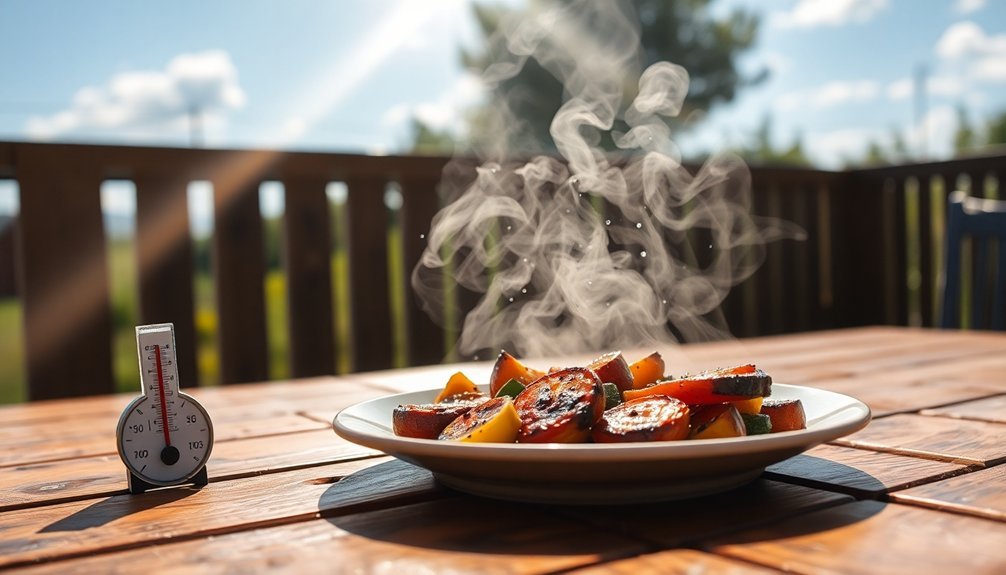
You'll want to check the day's UV index before starting your solar cooking session, as higher UV levels typically result in faster cooking times.
Make it a habit to monitor the UV index through a weather app or local forecast, which helps you better predict how long your meals will take to cook.
Based on the UV readings, you can then adjust your cooking time settings up or down to achieve the perfect doneness for your sun-based dishes.
Monitor UV Index Daily
Monitoring daily UV index readings serves as an essential step in temperature control for sun-based cooking methods.
You'll want to check UV forecasts between 10 a.m. and 4 p.m., when levels typically peak, to optimize your cooking schedule. Higher UV index values indicate stronger solar radiation, which directly affects your meal's heating efficiency.
You can track UV levels using wearable devices connected to mobile apps or by checking local weather services. For precise measurements, look for devices with calibrated sensors that match the erythema action curve.
Remember that UV intensity varies by location – you'll experience stronger readings at higher elevations and lower latitudes. Keep in mind that regional factors like ozone layer thickness can impact UV levels, particularly in the southern hemisphere where readings tend to be higher.
Adjust Cooking Time Settings
Successful solar cooking requires careful attention to temperature control and timing adjustments. You'll need to monitor your solar oven's temperature, which should reach at least 250°F for best results. Keep the lid closed as much as possible and use a calibrated thermometer to check food temperatures rather than relying on set cooking times.
| Setting | Sunny Day | Partly Sunny | Cloudy Day |
|---|---|---|---|
| Temperature Range | 250°F+ | 200-250°F | Below 200°F |
| Cooking Speed | Normal | 1.5x longer | Not recommended |
| Peak Hours | 10am-4pm | 11am-3pm | Use alternatives |
| Lid Checks | Every 30min | Every 45min | N/A |
Remember to refocus your oven every 30 minutes to maintain consistent heat. Use dark-colored cookware to enhance heat absorption, and always keep food out of the danger zone (40°F-140°F) to guarantee safety.
Lid Design and Heat Retention
The design and fit of a lid play an important role in maintaining ideal heat retention during moist-heat cooking.
You'll want to make sure your lid fits snugly to trap steam and prevent heat from escaping, which is vital for even cooking and proper self-basting.
High-quality materials like tri-ply stainless steel with aluminum cores offer superior heat conductivity, while dimpled lids enhance the basting effect by directing condensation back onto your food.
When you're cooking with sun-based methods, proper lid design becomes even more significant as it helps create a controlled environment that circulates heat uniformly.
You'll find that a well-fitted lid not only concentrates flavors by allowing herbs and spices to infuse deeply but also helps tenderize tougher cuts of meat through slow, moist cooking.
Transparent Heat Trap Solutions
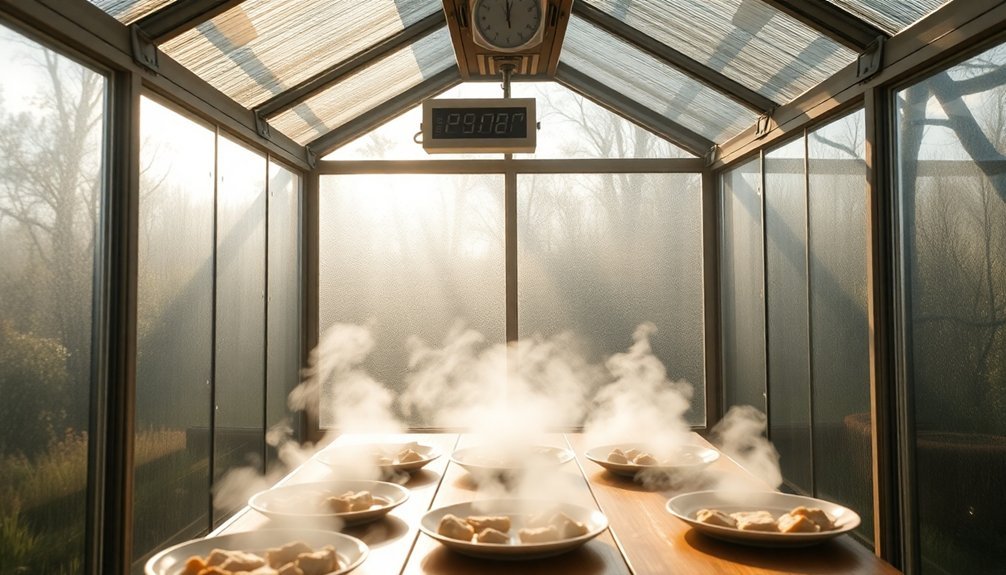
Building on effective lid design principles, transparent heat trap solutions take solar cooking to new heights.
You'll find these materials working like a one-way street for heat: letting sunlight in while preventing heat from escaping. Advanced aerogel technology has revolutionized this concept, transmitting over 95% of sunlight while maintaining superior insulation.
- Glass or plastic tops can help your solar cooker reach up to 300°F (150°C)
- MIT's aerogel technology pushes temperatures above 392°F (200°C)
- Reflective surfaces enhance heat concentration for better cooking results
- Transparent covers paired with reflectors create an efficient cooking system
When you combine these transparent materials with reflective surfaces, you'll maximize heat retention and cooking efficiency.
This setup traps moist heat effectively, ensuring your food cooks thoroughly while maintaining proper moisture levels.
Weather Impact on Moisture
While solar cooking relies heavily on clear skies, weather conditions greatly affect moisture levels in your food. When you're cooking on hot, humid days, you'll notice that moisture retention in food increases as warmer air holds 7% more water vapor for each 1.8°F rise in temperature. This can impact your cooking times and food texture.
You'll need to take into account the heat index, which combines temperature and humidity to determine how hot it actually feels. On days when humidity is high, you might find that your food retains more moisture than expected.
However, in arid regions, you'll experience different results due to higher vapor pressure deficits. The moisture content in your food can vary considerably based on whether you're cooking in direct sunlight, which can increase the heat index by up to 15°F.
Equipment Maintenance for Water Retention

Managing moisture levels effectively requires proper maintenance of your water retention equipment.
You'll need to implement preventive maintenance schedules and real-time monitoring systems to guarantee peak performance. Regular inspections and automated sensors help you detect issues before they become serious problems.
- Install quality pressure vessels and RO pumps for reliable operation
- Train your staff thoroughly on equipment operation and troubleshooting
- Monitor UV light intensity and membrane efficiency continuously
- Follow clear SOPs for maintenance and problem resolution
Your success depends on selecting high-quality equipment and partnering with reliable suppliers.
Make certain you're checking raw water storage systems, filters, and UV disinfection units regularly. By maintaining proper water pressure and flow rates while monitoring key quality parameters like pH and conductivity, you'll keep your moisture retention systems running efficiently.
Proper Food Preparation Guidelines
Success in moist heat cooking depends on following precise preparation guidelines that maximize both safety and flavor. You'll need to monitor water activity levels carefully, keeping them below 0.85 to prevent microbial growth. When you're steaming or simmering foods, maintain proper temperature control and use appropriate equipment for each method.
| Method | Temperature | Best For |
|---|---|---|
| Steaming | 212°F | Vegetables, Small Meats |
| Simmering | 180-205°F | Tough Cuts, Legumes |
| Braising | Variable | Large Meat Portions |
For ideal results, you'll want to start by searing meats before braising them in liquid. When steaming, use a proper basket to keep food elevated above water. Remember that different cooking methods require different preparation approaches – steaming needs minimal prep, while braising demands more attention to achieve fork-tender results.
Frequently Asked Questions
Can Solar Cooking Destroy Harmful Bacteria as Effectively as Traditional Cooking Methods?
Yes, you'll find solar cooking destroys harmful bacteria as effectively as traditional methods. It maintains consistent temperatures for longer periods, ensuring thorough bacterial destruction, just like boiling or pressure cooking your food.
How Does Altitude Affect Moisture Retention in Solar Cooking?
At higher altitudes, you'll notice faster evaporation due to lower air pressure. You'll need to add 10-25% more liquid depending on your elevation, and use moisture barriers to maintain proper cooking conditions.
What Materials Should Never Be Used in Solar Cookers?
You shouldn't use cardboard, unsealed wood, flammable items, toxic plastics, or brittle materials in your solar cooker. They're either unsafe, can't handle heat, or will break down when exposed to moisture.
Does Food Color Affect Cooking Time and Moisture Retention?
No, your food's color doesn't directly affect cooking time or moisture retention. Instead, it's your cooking method, temperature, and moisture content that determine how long it takes to cook and stay juicy.
Can Solar Cooking Work Effectively in Humid Climates?
You'll face challenges using solar cooking in humid climates. High moisture reduces sunlight intensity and creates condensation on cooking surfaces. You're better off solar cooking in dry regions with consistent sunshine.
In Summary
You'll find that proper sealing and container choices make all the difference in retaining moisture during solar cooking. By implementing effective heat traps, maintaining your equipment, and following correct food prep methods, you can prevent unwanted moisture loss. Remember to adjust your cooking approach based on weather conditions and use appropriate temperature controls to keep your sun-cooked meals moist and flavorful.

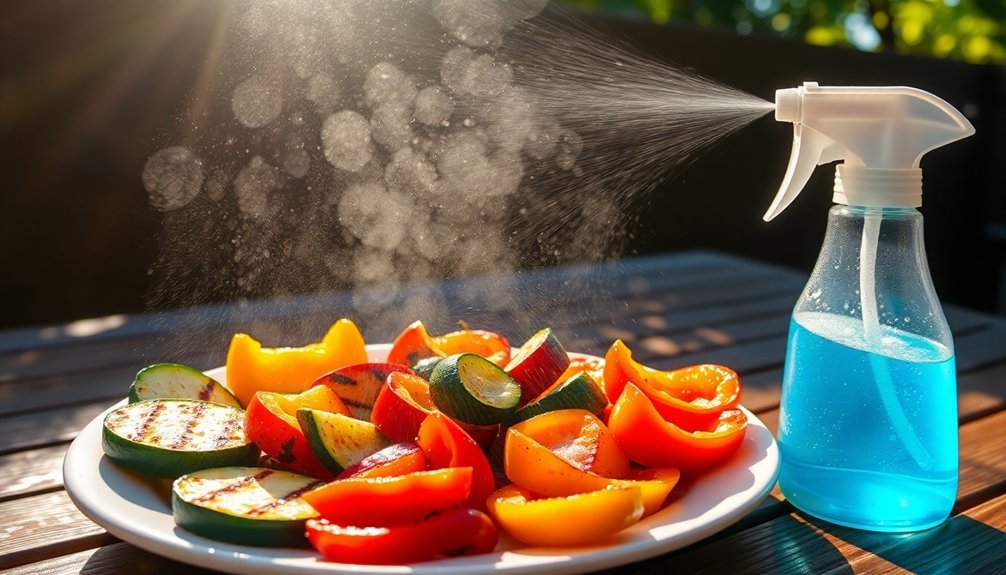



Leave a Reply